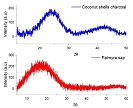The Optical Energy Gap of the Semiconducting Intrinsic Layer for Organic Solar Cell Applications
DOI:
https://doi.org/10.19184/cerimre.v6i1.39254Keywords:
Amorphous phase, Coconut shells charcoal, Optical energy gap, Palmyra sugarAbstract
The optical energy gap of the semiconducting intrinsic layer plays a crucial role in determining the increase in efficiency. The carbon-based biomass can be a choice for the silicon used as solar cell material. Here, we proposed the best biomass that can be used as a semiconductor component in solar cell applications. Coconut shells as bio-waste and palmyra sap, which are available in most areas of Indonesia, can be the best candidates to be considered. The XRD measurement showed both organic materials have an amorphous phase. The coconut shells sample has two peaks that are identical to graphene peaks, therefore this material is called graphenic-like carbon (GC). Furthermore, from the UV-visible spectroscopy, it was shown that both materials have a high transmittance of more than 95%, which indicates that they have transparent properties. Also, the Tauc plot method gives information about the optical energy gap of coconut shell charcoal (GC) and palmyra sap (a:C) which are 2.67 and 1.83 eV, respectively. From this result, palmyra sap becomes promising material to be applied as an intrinsic layer for semiconducting components in solar cell applications.
Keywords: Amorphous phase, Coconut shells charcoal, Optical energy gap, Palmyra sugar.









